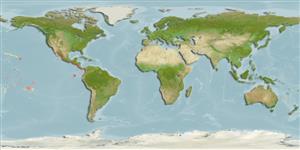>
Anguilliformes (Eels and morays) >
Chlopsidae (False morays)
Etymology: Chlopsis: Greek, chloea = green + Greek, opsis = appearance (Ref. 45335).
More on authors: Beebe & Tee-Van.
Environment: milieu / climate zone / depth range / distribution range
Ekologi
marina bottenlevande; djupintervall 80 - 130 m (Ref. 96339). Tropical
Eastern Pacific: coast of Central and South America from Mexico to Colombia
Size / Vikt / Age
Maturity: Lm ? range ? - ? cm
Max length : 25.0 cm TL hane/ej könsbestämd; (Ref. 96339)
Short description
Bestämningsnycklar | Morfologi | Morfometri
Ryggkotor: 134 - 140. Head and body pigment uniformly distributed and sharply demarcated, heavily pigmented dorsally, unpigmented ventrally; white stripe of snout; dorsal fin origin behind gill opening (Ref. 40870).
Life cycle and mating behavior
Könsmognad | Reproduktion | Lek | Ägg | Fecundity | Larver
Lavenberg, R.J., 1988. Chlopsid eels of the eastern Pacific with a new species and descriptions of larval forms. Bull. Mar. Sci. 42(2):253-264. (Ref. 40870)
IUCN Red List Status (Ref. 130435: Version 2024-1)
Threat to humans
Harmless
Human uses
Verktyg
Special reports
Download XML
Internet-källor
Estimates based on models
Preferred temperature (Ref.
123201): 14.6 - 20.6, mean 15.3 °C (based on 7 cells).
Phylogenetic diversity index (Ref.
82804): PD
50 = 0.5002 [Uniqueness, from 0.5 = low to 2.0 = high].
Bayesian length-weight: a=0.00102 (0.00046 - 0.00225), b=3.06 (2.88 - 3.24), in cm total length, based on all LWR estimates for this body shape (Ref.
93245).
Trofisk nivå (Ref.
69278): 3.9 ±0.6 se; based on size and trophs of closest relatives
Fishing Vulnerability (Ref.
59153): Low vulnerability (15 of 100).
